


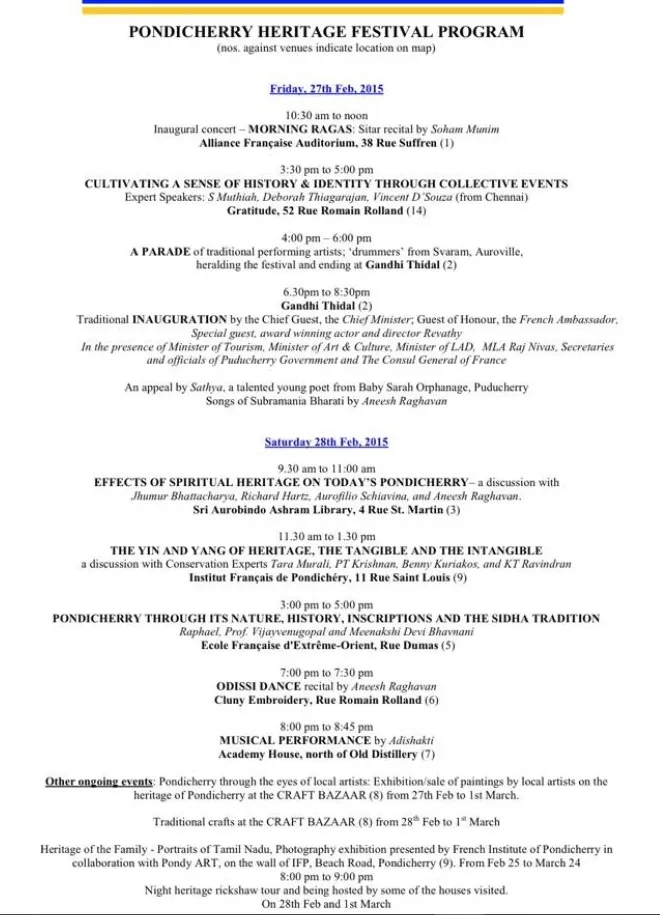
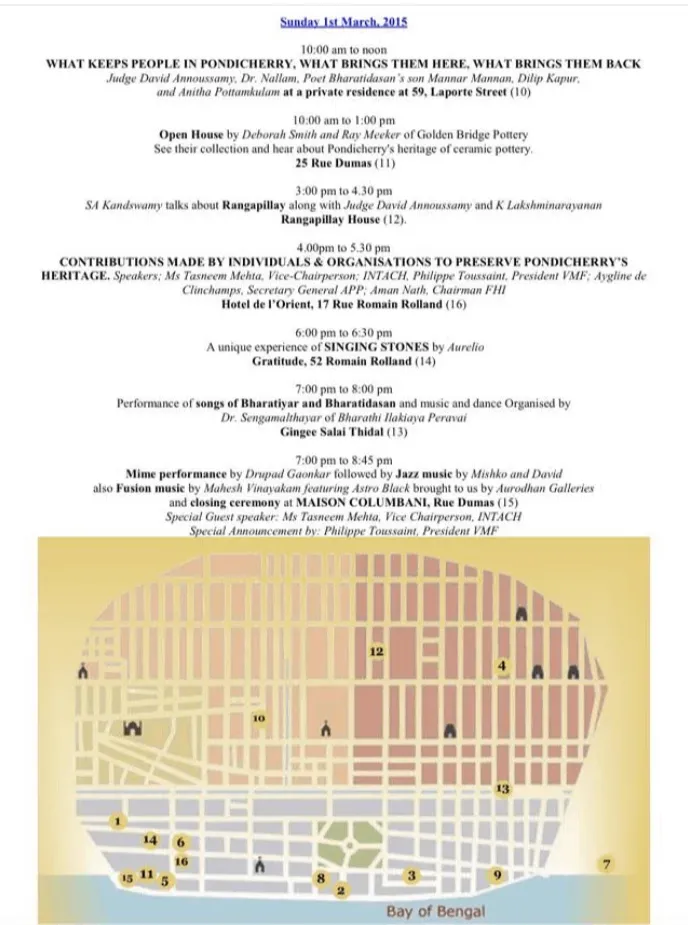
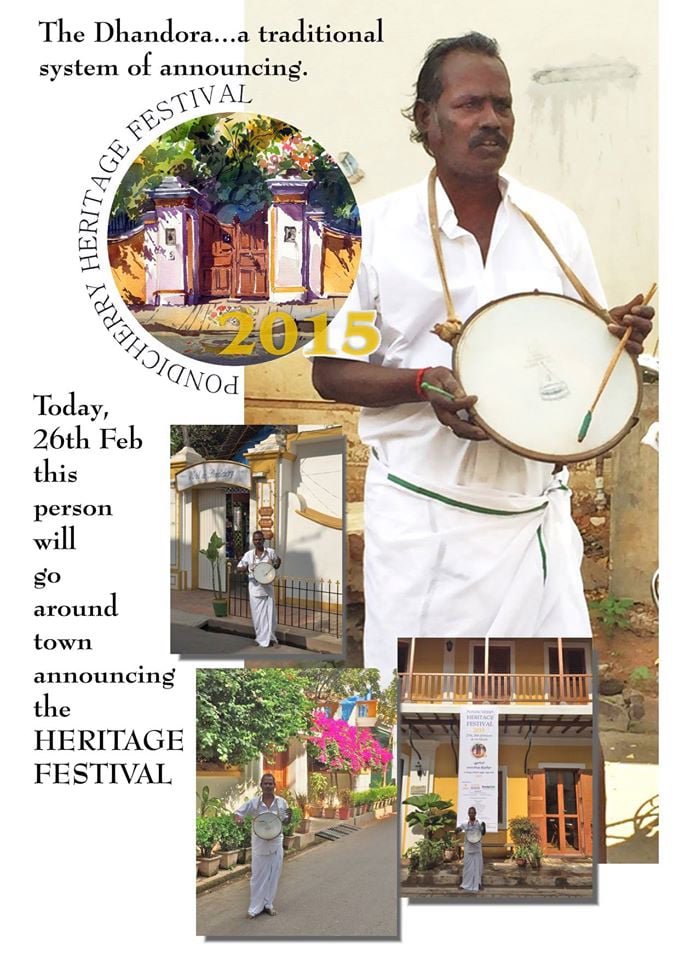
THE CURTAIN RAISER: In true traditional fashion, a drummer went round town the before the Pondicherry Heritage Festival 2015, beating his drum, inviting everyone to attend the events of the following three days.
On the morning of 27th February, young Soham Munim took the packed auditorium of the Alliance Francaise to a whole different realm with his long and deep alap in Bilaskhani Todi, on his sitar. Then accompanied by the equally talented Raveesh Shet on the tabla he enthralled them all with beautiful compositions in two other morning ragas before ending with a dhun.
The auditorium of the Alliance Francaise was soon filled to maximum capacity.
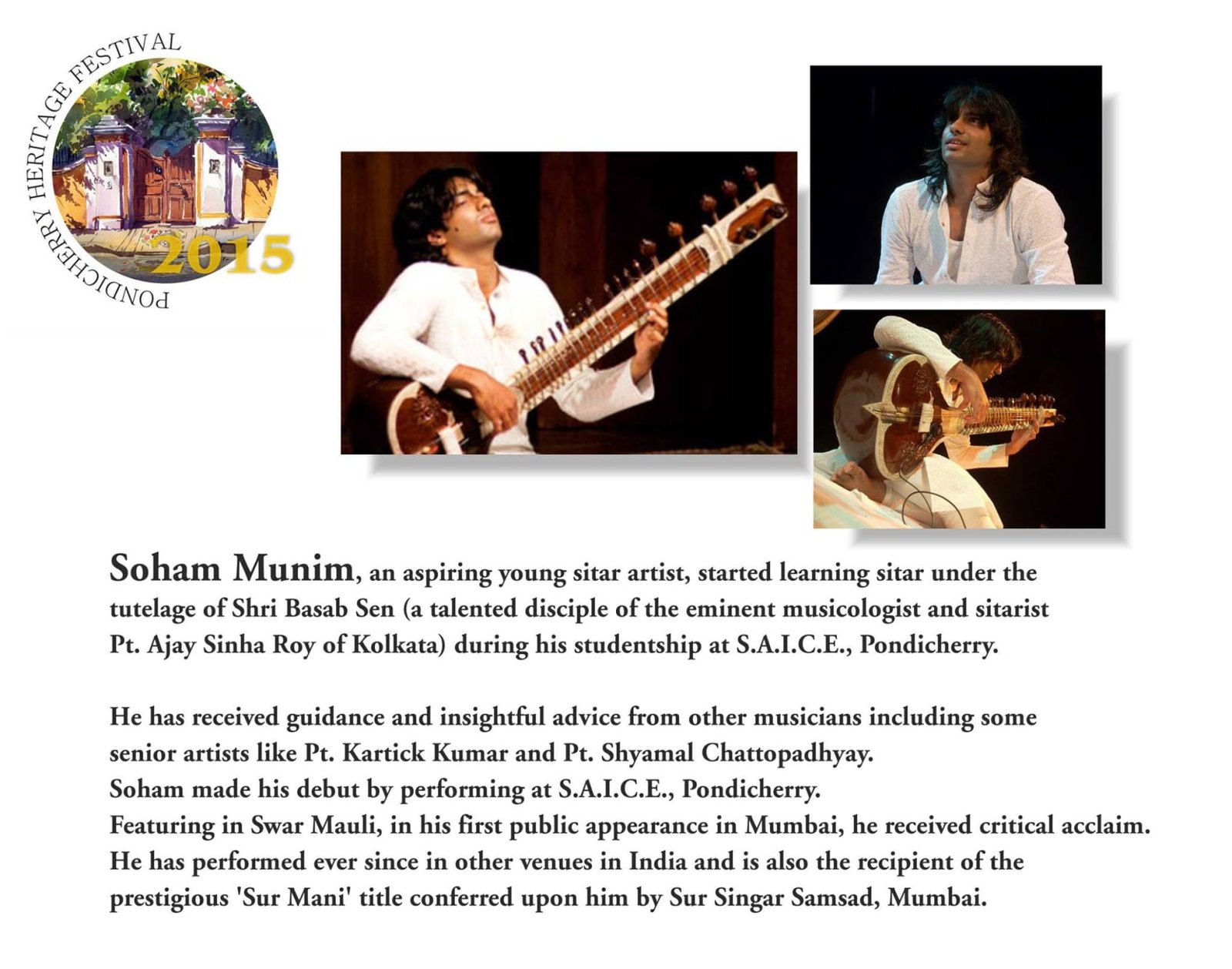
Video Description
The INAUGURATION event started with local artists performing through the town. Two groups of dancers, the Therakoothu group in one van, the Silambattam group in the second and Auroville’s Svaram drummers in a third, stopped at a few locations and performed their wonderful acts, much to the amazement of the people gathered on the streets. They assembled at the location of the inauguration at the Gandhi Thidal performing amidst a wide circle of people and setting the tone of the Festival, calling the residents of Pondicherry to participate in large numbers.
That afternoon, in the courtyard of the beautifully restored old house of Gratitude, people listed enthusiastically to S. Muthiah the Chennai historian, Deborah Thiagarajan the creatrix for Dakshinachitra, and Vincent D’souza, the journalist who started the now famous Mylapore festival as they spoke about “Cultivating a sense of history and identity though collective events”.
They emphasised that any activity which centres on heritage conservation must involve the people of the city to take pride in their heritage. They stressed on the importance of involving children and school in campaigns for heritage conservation. “Children will bring heritage forward” said Deborah Thiagarajan. They all agreed on heritage extending beyond built heritage to include cultural, environmental and spiritual heritage.
The event was moderated by Anita Pottamkulam.
.
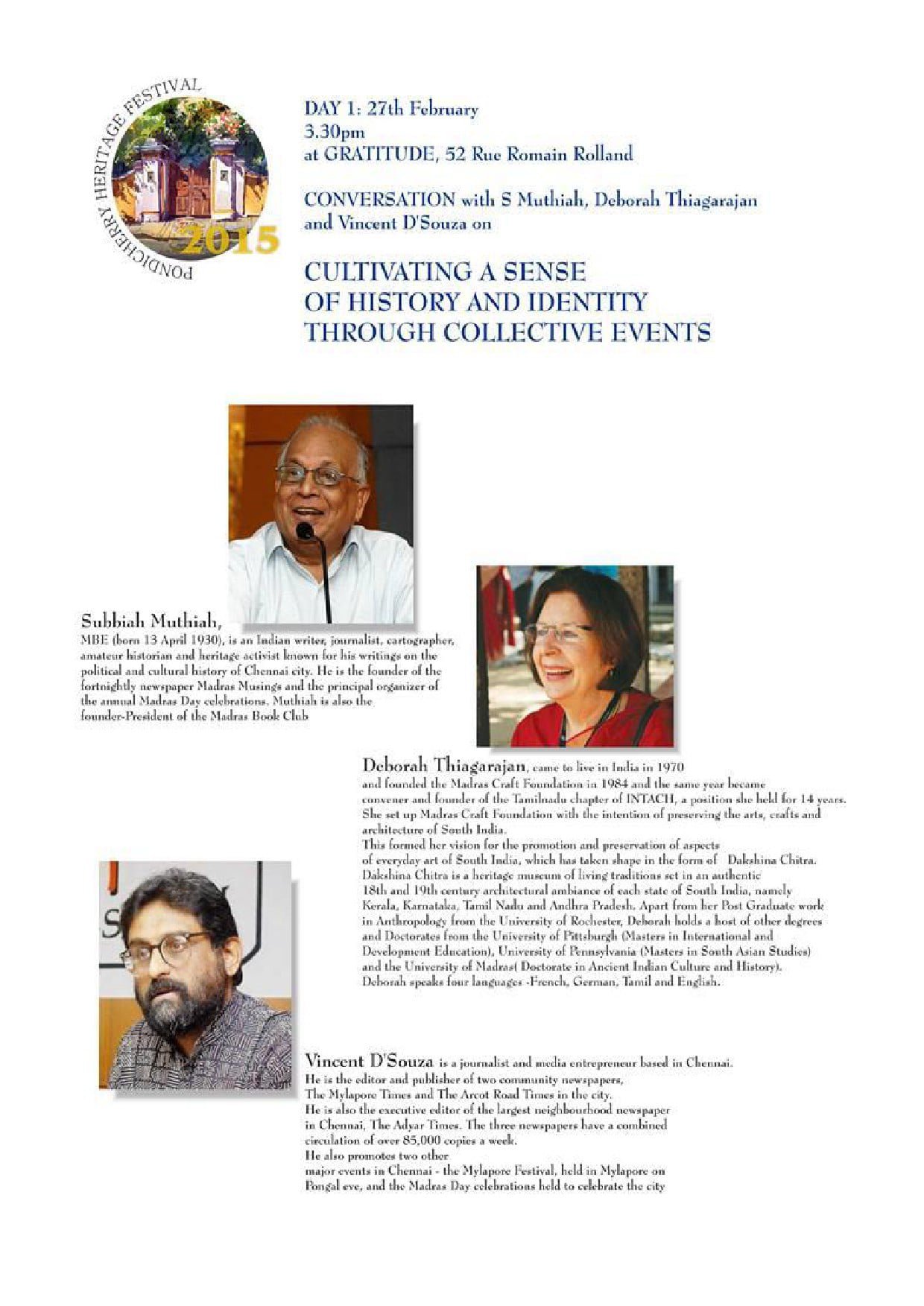
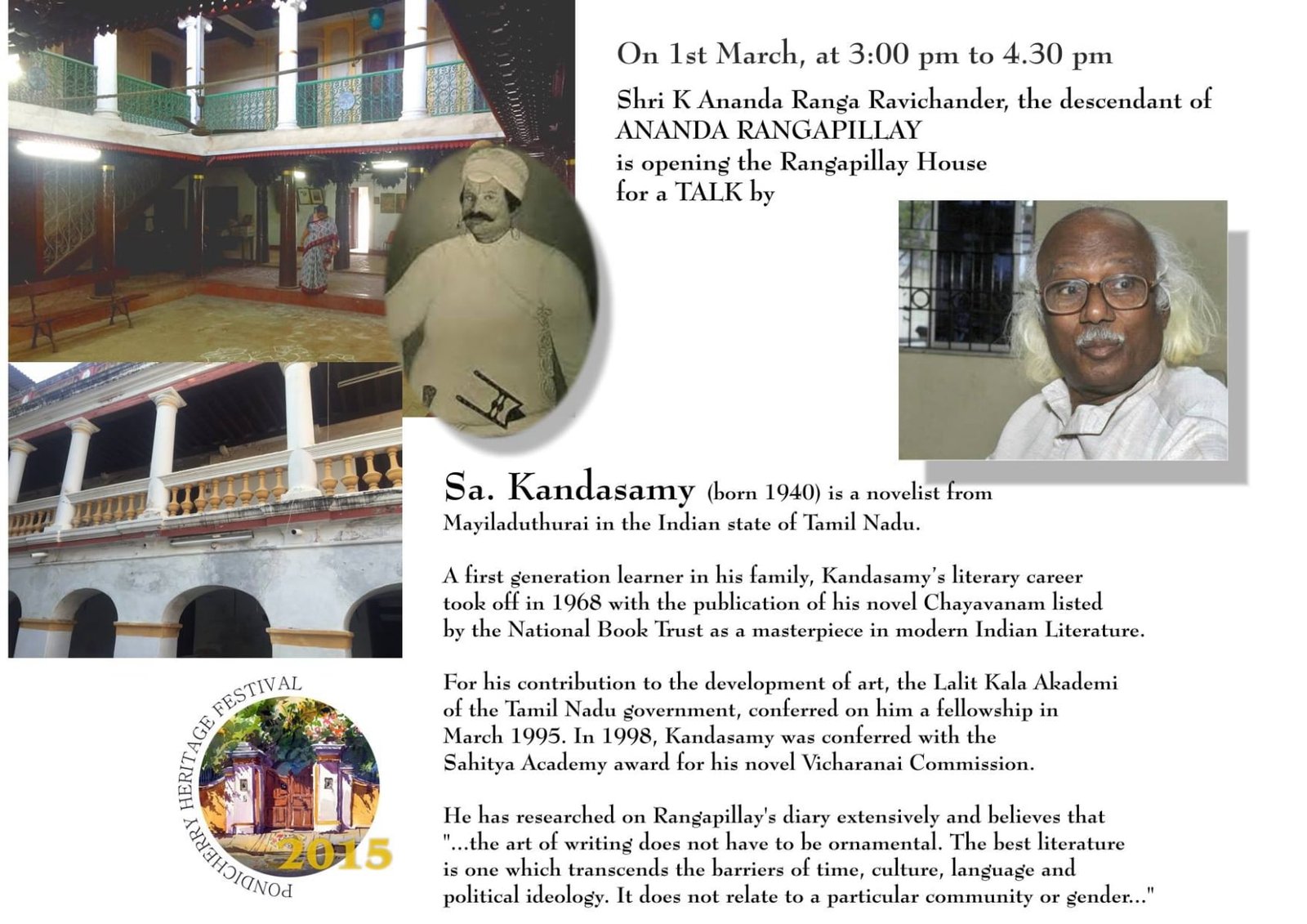
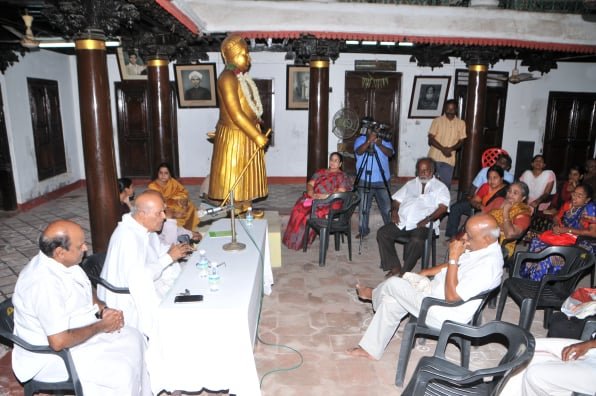


The next discussion was a talk by SA Kandaswamy on Ananda Rangapillai, at the Rangapillay House on Rangapillai street, right across from the entrance to the main market. One had to wade carefully through onion peels strewn across the entrance way, and enter this rather non-descript doorway that led to a wonderfully carved traditional door which opened out into this large wonderful space. The talk was well attended, with Judge David Annousamy and Shri Lakshminarayanan adding to the expert’s points. This is one historic heritage house which is in desperate need of preservation, although looked after to the best of their capacity by the descendants of Ananda Rangapillay.
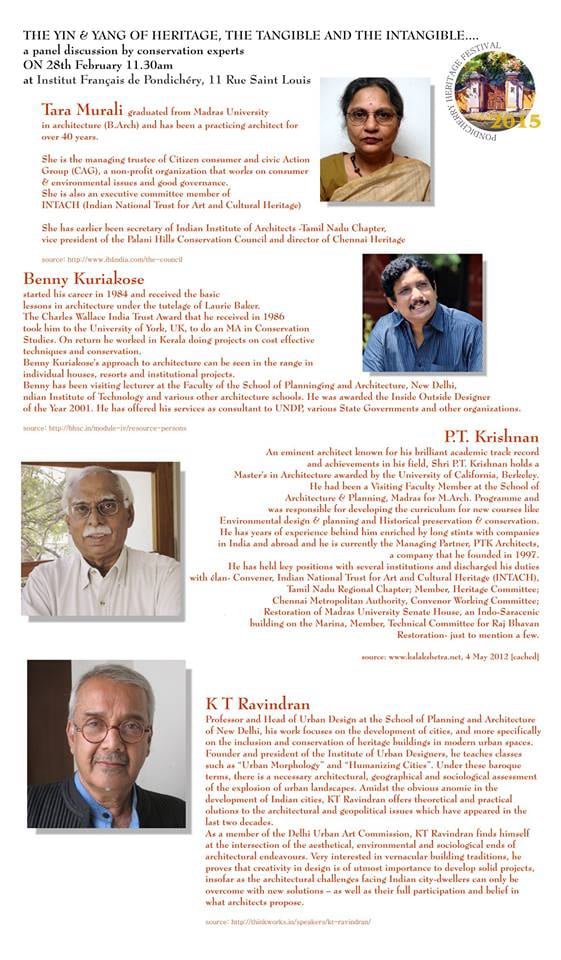
with Tara Murali, P. T. Krishnan, and KT Ravindran, was held at the beautiful conference room of the Institut Francais de Pondichery, to a packed audience of Pondicherians, including the local MLA, architects, and many students of architecture from nearby colleges, some from as far away as Chennai. The room had to be rearranged to fit everyone.
They touched upon infusing humanity in planning, introducing a calming in the cities where today speed is power, including urban renewal as part of planning, making engineers employable through training, remembering the importance of legends which are often linked to physical spaces the disappearance of which, causes them to disappear and alienate people from their very culture; the importance of people being custodians of their culture and working towards resolution of all issues to the larger public good. They spoke of the importance of participatory planning which though mandated through the 74th amendment, is rarely practiced anywhere in our country. It is unfortunate that social aspects are missing in planning, when at the end for the day, planning is and should be for people. Land today is only an economic asset, we need to bring back its value by mapping what happens on it, the artisans, and the traditions.
The intense session with an extended interaction with the audience went over the allotted time of two hours by a full forty-five minutes.
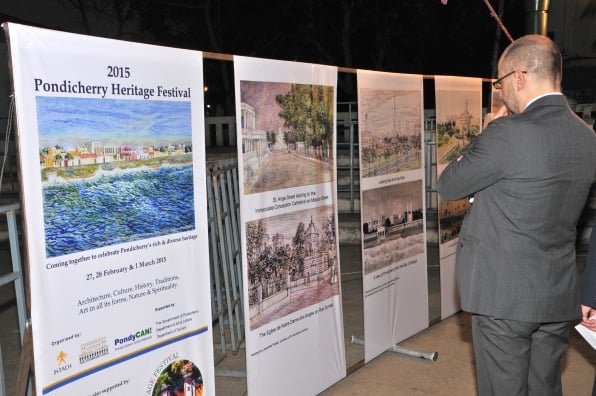
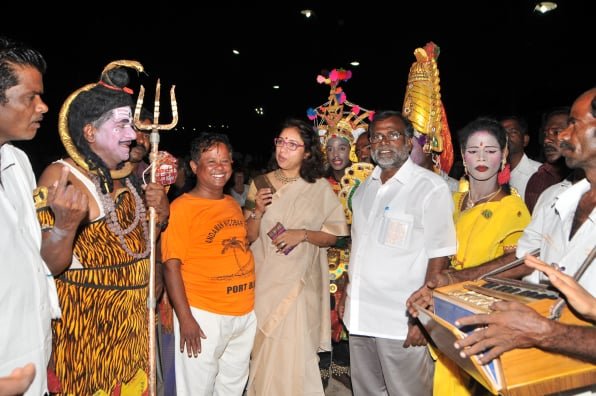
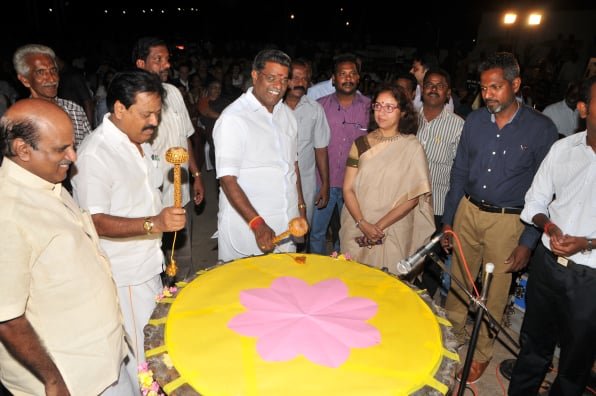
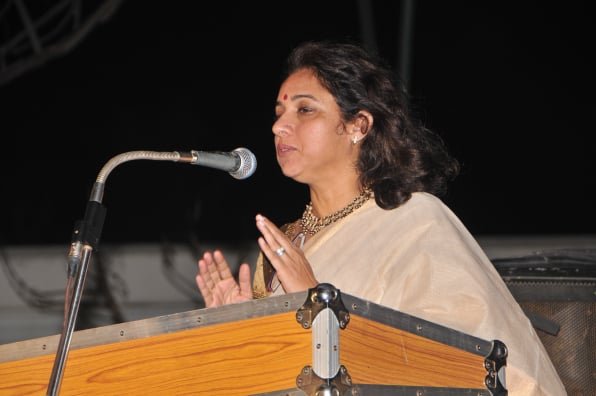
.Aman Nath of the Neemrana group concluded that in spite of their being parallel priorities, we owed it to our children to leave something tangible for them from our lives, and built heritage is something that everyone can recognise, and therefore important to preserve. India is a living civilisation, and here we have new ways of doing things. Sometimes we don’t care as we believe in the impermanence of things but unless we do something, there will be nothing left.
The Hotel de l’Orient hosted a presentation on the attempts of architect Kamalhasan to preserve the wonderful heritage of his village and the surrounding rich area of Chettinad. He has painstakingly documented parts of this region, which is fast losing its beautiful neighbourhoods as the owners live in the cities and their children often overseas. So no one is interested in caring for the ancestral homes of their enterprising forefathers who went across the Bay of Bengal and traded far into the East.
Philippe Toussaint the president of VMF, the biggest heritage organisation in France, presentation their work in Pondicherry and in Chandranagore. He also showed interesting examples of how there was an Indian influence on architecture in France and added that we were not the only ones fighting to save our heritage, ‘we are fighting every day in France too, stones don’t shout when you murder them’. He added that in France, the area of protection around heritage extends to the landscape and also to the arts and crafts.
The Vice Chairperson of INTACH Tasneem Mehta reminded everyone that colonial buildings may have been built by the colonial powers, but they were built by Indians, for Indians and adapted for India. Her presentation was on the renovation of the erstwhile Victoria and Albert museum in Mumbai, now named the Bhau Daji Lad museum, a project on which she worked from 2000 and how today it is a very successful example of how a building can be repurposed, modernised in its contents, and become a public space that educates and entertains people. Involving the local community in the project, the local government, and local philanthropic organisations, they were able to raise enough funds to do the renovation and also a restoration of its collection, but also acquire new things that harmonise with existing works of art. The project is so successful that they have raised enough funds to build a new extension. She made an interesting observation, that today, the concept of artisans and crafts people is gone and replaced by just labourers, and this has to be reversed. She commended the work of the Pondicherry chapter of INTACH. Though it was her first visit she made it clear that she already wanted to come again. She felt that the kind of movement we had begun, was very encouraging and would definitely yield results

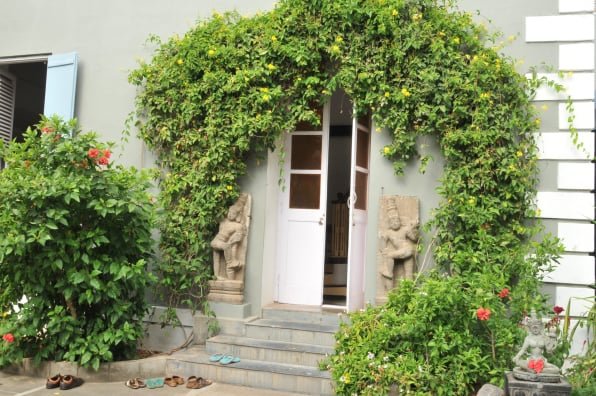
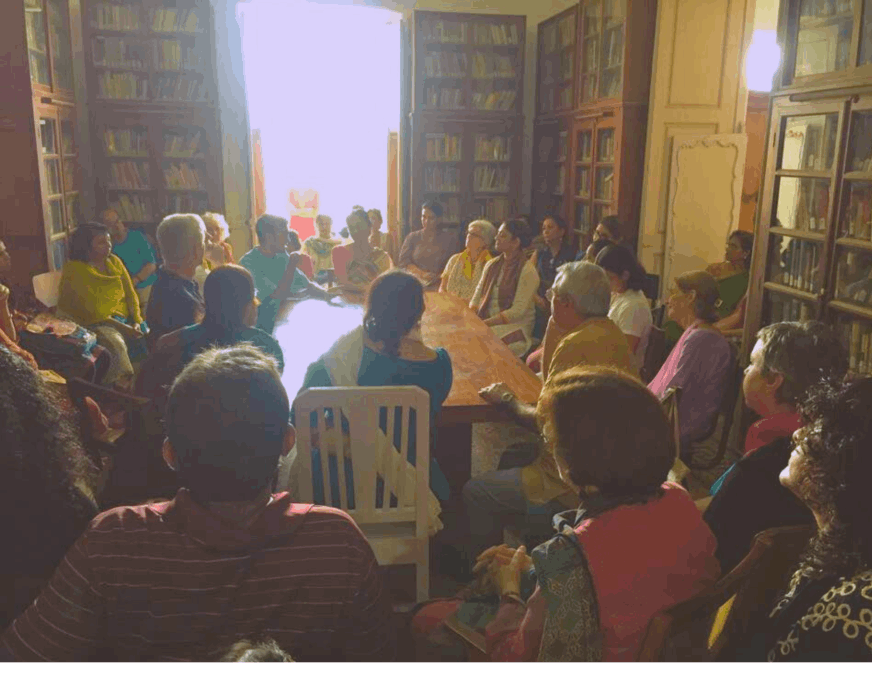

at the Selvaraja Chettiar Mansion, in the fishing village of Kuruchikuppam, past the northern end of the boulevard town.
The lit pathway, showed the silhouette of the crumbling but magnificent building. People entered the traditional Tamil room with the open to sky inner courtyard and filled in every single centimetre of space they could find, including in an around the drummers and singers and musicians from Adishakti. It was definitely a performance which had the audience clapping their hands and whistling and clamouring for more.
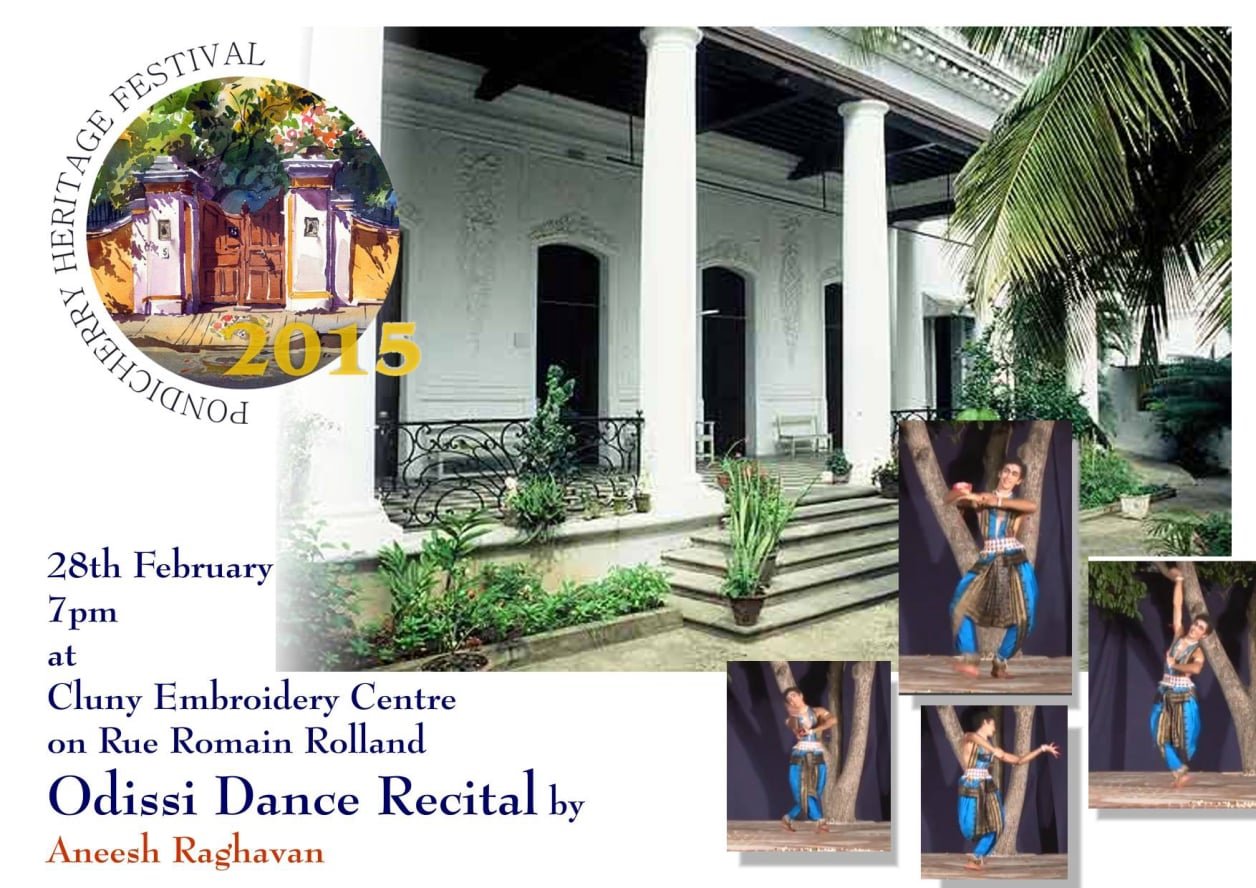
As evening fell, everyone gathered in the impeccably maintained courtyard and veranda of the Cluny embroidery section to be totally captivated by Aneesh Raghavan’s Odissi rendering of Dashavatara, followed by a story of Krishna and ending with a spectacular dance to the sun god Surya. People managed to fill every nook and corner of that compound to watch this electric performance. The sisters of Cluny were awarded the VMF Plaque in recognition of their maintenance of a historic building.
The last session of the day was in the library of the Ecole Francaise d’Extreme-Orient.
The historian Raphael Malangin started with a presentation with old photos of the sea front of Pondicherry and the history of the Town Hall, or the Mairie, the building which had collapsed in November 2014, and what brought so many Pondicherians together to be part of the movement the People for Pondicherry’s Heritage, who were one of the three organisers of the festival.
Prof Vijayyvenugopal then shared his twenty years of painstaking research on the history of Pondicherry through inscriptions found in temples, churches, bazars, buildings, and cemeteries. These weave an interesting history from the Chola period through the other rulers to the colonial rulers. Meenakshi Devi Bhavnani, an American by birth and now a long time Indian citizen spoke of the history of Pondicherry from the time Agastya Rishi came here across the Vindhyas, through a series of sidhas some of whom established madams which exist to this day.
On 1st March the events started at Judge David Annousamy’s house which he had graciously opened up to the public for the discussion on “What keeps people in Pondicherry, what bring them here and what bring them back”. Anitha Pottamkulam moderated the lively discussion with Dr. Nallam, Mannar Mannan (poet Bharatidasan’s son), Judge David Annousamy, and Dilip Kapur.
The beautiful room of his traditional Tamil house was filled with the complete spectrum of Pondicherians, those here since generations, those born and brought up here, those here since a young age, or those who married into Pondicherry and made it their home, or those who came here to study and never left, to those who went out to study and came back, and those who keep coming here, not knowing why, or those who just can’t stay away. They were from all parts of India and the globe. A truly diverse group so representative of Pondicherry. The discussion ranged from what to call the French part of town as no one liked it being called ‘white town’, all these many years after independence, to whether the residents of Pondicherry wanted to attract more tourists or were they were adversely affected by the crowds that came here every weekend and cluttered our peaceful Pondicherry. Judge David brought it all back by asking almost everyone in the room why were they here and single common factor was because of the way of lifeand the quality of life here. SA Kandaswamy surprised everyone by saying that when one travelled along the coast of Tamilnadu, one could tell the difference when one entered Pondicherry as the people were always friendlier. Hospitality is a particular Tamil virtue, probably an Indian virtue, and Pondicherry has a good dose of it.
Another interesting point which came out of this discussion was that it was equally important to save and conserve the Tamil heritage including the many temples in and around the town, many of them in a very sorry state, with damage being done to them, some of them 300 to even 800 old. Another point was the need for the residents to engage in the planning and development of their town. After all it is their lives that are affected directly, and they must have a say.
Ray Meeker and Deborah Smith, the legendary Pottery artists of The Golden Bridge Pottery, who have trained many a potter and have chosen to live in Pondicherry, opened their house on Rue Dumas to visitors to share their work and meet and talk to them.
Craft Bazaar-Local art and artisans
Closing Ceremony events
While one part of the crowd then walked over to Gratitude, to hear Aurelio’s singing stones, another group headed to the northern end of the boulevard where Dr.A. Susairaj and party performed songs of Subramania Bharati.
Then about fifteen students did a combination of classical dance to the music compositions of Subramania Bharati and others.
At Gratitude, the evening echoed with the solid yet elusive music, of the polished granite singing stones and then sounding their gongs and their other instruments, Aurelio and the Svaram musicians led the whole crowd to the Maison Columbani for the concluding ceremony. This started with a mime performance by Drupad Gaonkar. VMF then gave out some awards to beautifully restored buildings and announced the starting of their work to restore the park of Joan of Arc opposite the Church which was restored by them earlier. This was followed by concluding remarks from Tasneem Mehta, the French Consul and the MLA. Then the Jazz duo of Mishko on base guitar and David on violin did renderings of Ave Maria followed by Vivaldi and finished with a popular piece of jazz music.
Sunaina Mandeen and Kakoli Banerjee then wrapped up the festival by announcing that this was going to be an annual event and that the circle of the People of Pondicherry’s Heritage was ever widening, and there was also support from the local government to take up the restoration of the listed buildings.
The festival ended with the elevating and innovative singing of Mahesh, blending his Carnatic style with tracks of music from different parts of the world.
.
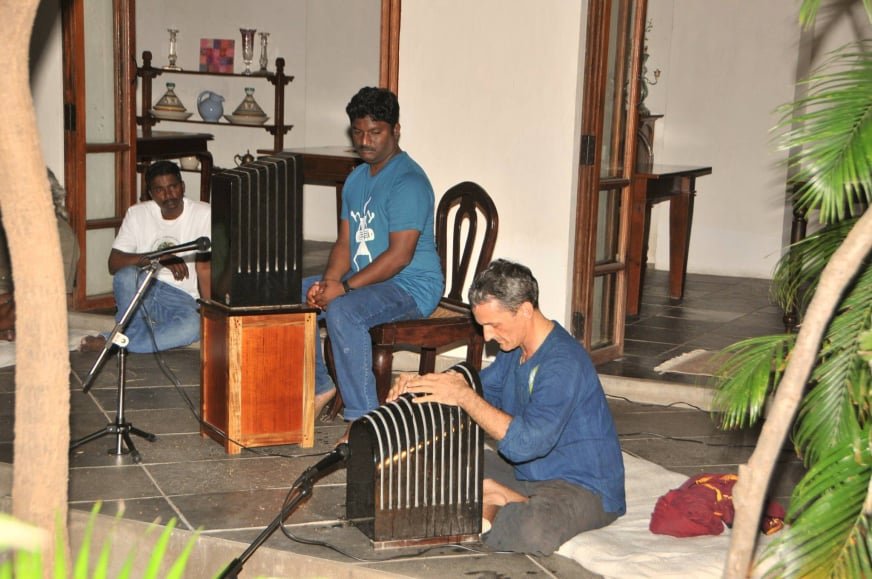

AI Website Software